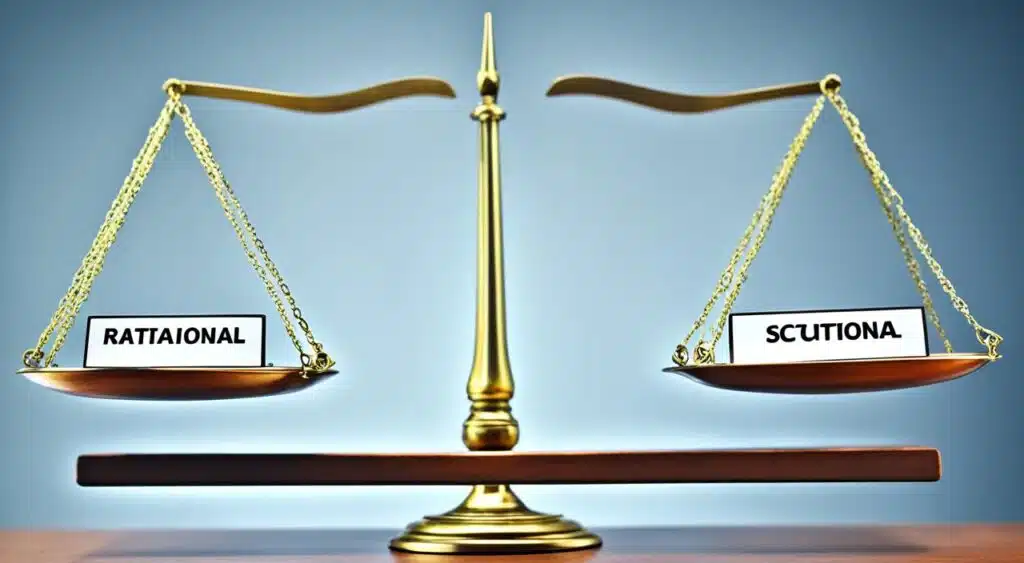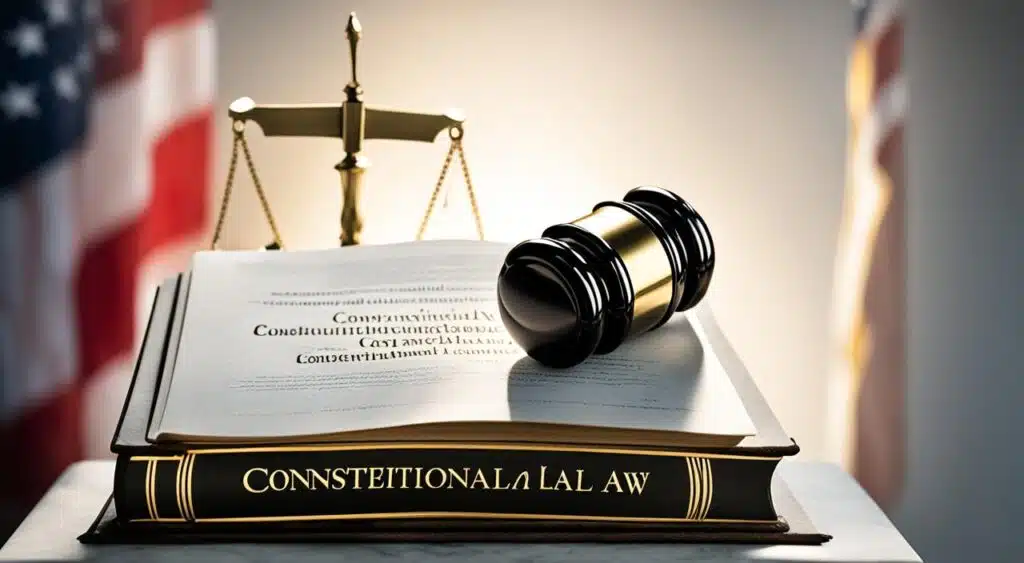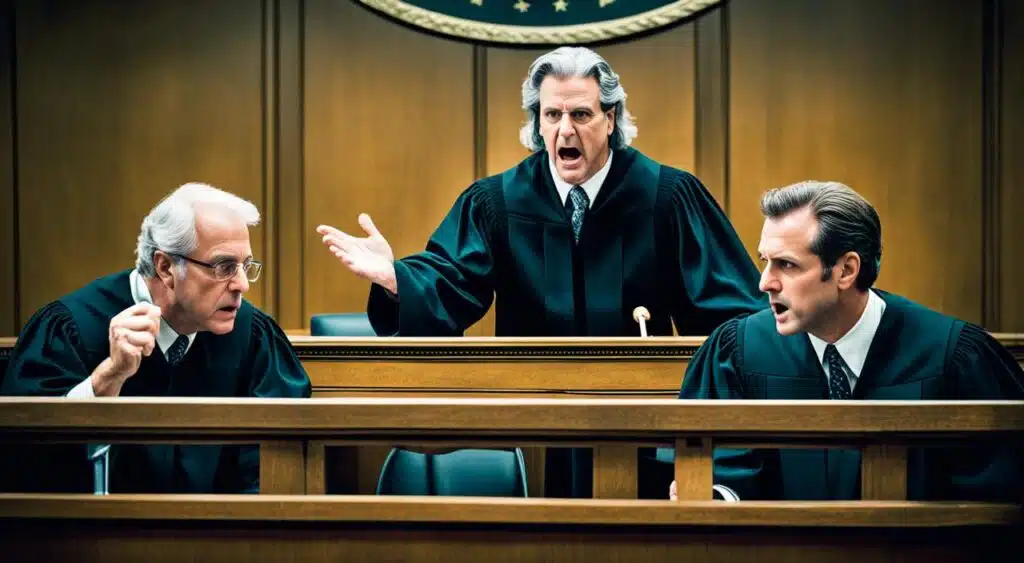Constitutional Law: The United States Constitution sets clear limits on what the federal and state governments can do. It bans things like bills of attainder and ex post facto laws. It also requires laws to be clear, protect everyone equally, respect free speech, and protect privacy.
The idea “no crime without law, no punishment without law” shows that making laws without trials or after the fact is wrong. Bills of attainder punish people without a trial. Ex post facto laws punish actions that happened before the law was made.
Laws must be clear so people know if they broke a law. The Constitution also makes sure everyone is treated fairly under the law. Laws that unfairly target people based on race or gender get extra scrutiny.
Key Takeaways
- The U.S. Constitution sets limits on the powers of federal and state governments.
- These limits include prohibitions on bills of attainder and ex post facto laws.
- The Constitution also requires statutory clarity, equal protection, and freedom of speech.
- The rule of legality, or “no crime without law, no punishment without law,” reflects the illegality of bills of attainder and ex post facto laws.
- Statutes that make distinctions based on race or national origin are subject to strict scrutiny, while those based on gender are subject to intermediate scrutiny.
Constitutional Limitations: An Overview
The Constitution sets limits on what the federal and state governments can do. It bans bills of attainder and ex post facto laws. It also demands statutory clarity, equal protection, and freedom of speech.
The Rule of Legality
The rule of legality means no crime or punishment without a law. This rule stops bills of attainder and ex post facto laws. Bills of attainder punish people without a trial. Ex post facto laws punish crimes committed before the law was made.
Legislation must be clear to avoid confusion. This ensures people know if their actions broke a law at the time.
The Constitution also demands equal protection of the laws. Laws that unfairly target race or origin face strict review. Laws that unfairly target gender get less strict review. These reviews help decide if laws are fair, especially in criminal law cases.
“The rule of legality, expressed by the Latin phrase ‘nullum crimen sine lege, nulla poena sine lege’ or ‘no crime without law, no punishment without law,’ reflects the illegality of bills of attainder and ex post facto laws.”
Equal Protection and Scrutiny Levels
The equal protection clause of the Constitution makes sure everyone gets the same treatment under the law. It stops the government from unfairly treating people differently. But, it says some differences are okay if they have a good reason.
When laws treat people differently based on race or where they come from, they get a very close look from judges. This is called strict scrutiny. It’s the highest level of review because treating people unfairly because of their race is a big deal.
Laws that treat men and women differently get looked at closely too. But not as closely as race-based laws. This is because men and women are biologically different, and some differences can be justified for good reasons.
Even though the equal protection clause is important, laws can still make differences based on things like how old someone is or the seriousness of a crime. As long as these differences make sense for a legitimate government purpose, they’re okay. This is the rational basis test, the lowest level of review.
Understanding the equal protection doctrine has been a complex journey. Courts have tried to find a balance between giving the government some room to act and making sure everyone is treated fairly. This balance is still a big part of how we interpret the Constitution today.
First Amendment: Freedom of Speech
The First Amendment to the U.S. Constitution protects our right to speak freely. This is key to our democratic system. But, the government can limit some kinds of speech that are not protected. It’s important to understand these limits to keep our democracy strong.
Unprotected Speech and Challenges
The First Amendment protects most speech, but there are exceptions. These include speech that calls for illegal actions, is obscene, or defames someone. These exceptions aim to stop harm and protect others. Yet, defining these exceptions can be tricky, leading to debates.
One issue is overbreadth, which means laws that go too far and limit too much protected speech. Laws must be made carefully to respect our First Amendment rights. The debate over hate speech is also ongoing. It’s hard to balance free speech with stopping harmful speech.
| Type of Unprotected Speech | Definition | Examples |
|---|---|---|
| Incitement | Speech that is intended to provoke immediate illegal action | Encouraging a crowd to commit acts of violence |
| Obscenity | Extremely graphic or vulgar material that lacks serious artistic, literary, political, or scientific value | Hardcore pornography |
| Libel | False statements of fact that damage a person’s reputation | Publicly accusing someone of a crime they did not commit |
“Congress shall make no law respecting an establishment of religion, or prohibiting the free exercise thereof; or abridging the freedom of speech, or of the press; or the right of the people peaceably to assemble, and to petition the Government for a redress of grievances.”
The First Amendment protects our right to speak freely, but it’s not absolute. Dealing with limits on speech and issues like overbreadth and hate speech is important. Lawmakers and courts must navigate these challenges carefully.
Constitutional Law
Constitutional law is a key part of the American legal system. It sets the rules for how the federal government and states work together. It also protects the rights and freedoms of every citizen. In law schools, it’s a main subject that helps students understand how the U.S. government works.
Students of constitutional law learn about the U.S. Constitution and the Supreme Court’s role. They study how powers are shared, how individual rights are protected, and how important court decisions have shaped the law.
Understanding constitutional law is crucial for legal professionals. It helps them know how the government is structured, how civil rights work, and how to interpret the Constitution. This knowledge is key to their work.
- The U.S. Constitution: The supreme law of the land, defining the structure and powers of the federal government.
- The Bill of Rights: The first ten amendments to the Constitution, protecting fundamental individual liberties.
- Judicial Review: The Supreme Court’s power to determine the constitutionality of laws and government actions.
- Equal Protection and Due Process: Constitutional guarantees of equal treatment and fair procedures under the law.
- Federalism: The division of power between the federal government and the states, with each level of government having distinct responsibilities and authorities.
By studying constitutional law, students get a deep look into the American legal system. They learn about the Supreme Court and the rights and freedoms in the Constitution. This knowledge is vital for understanding constitutional law, which is key in legal practice in the U.S.
Judicial Review and Interpretation
The power of judicial review is key in constitutional law. It lets courts, especially the Supreme Court, check if government actions are legal. They look at laws made by Congress. This way, courts help interpret the Constitution and set limits on government power.
When reviewing laws, courts must build them carefully. They try to understand what lawmakers meant and make sure their interpretation doesn’t lead to silly outcomes. The main goal is to follow the lawmakers’ clear intent.
Courts look at the law’s full picture, including its purpose, words, title, and history. They also check other laws and legal history for a clear and consistent view of the Constitution.
| Key Aspects of Judicial Review | Description |
|---|---|
| Constitutional Interpretation | Courts, led by the Supreme Court, interpret the Constitution’s meaning and scope. |
| Statutory Construction | Courts analyze and interpret laws carefully during review, looking at language and intent. |
| Avoiding Absurd Results | Courts aim to interpret laws in line with lawmakers’ intent, avoiding odd or unplanned effects. |
| Precedent and Case Law | Judicial views are influenced by past case law and stare decisis, ensuring consistency and stability. |
Judicial review is crucial for setting constitutional law’s limits and keeping the government in check. It’s vital for democracy and the rule of law.
Separation of Powers
The United States Constitution sets up a system of separation of powers. It divides the government into three main parts: the legislative, executive, and judicial branches. Each branch has its own powers to keep the others in check.
The legislative branch, or Congress, makes laws. The executive branch, led by the President, carries out these laws. The judicial branch, with the Supreme Court and lower courts, decides if laws are fair.
This setup stops any one branch from getting too much power. For instance, the President can stop laws passed by Congress. The courts can also say if laws or actions by the President are wrong. This system of checks and balances is key to the separation of powers in the U.S.
| Branch | Key Powers |
|---|---|
| Legislative Branch |
|
| Executive Branch |
|
| Judicial Branch |
|
Keeping the separation of powers and checks and balances is vital in the U.S. It ensures power is shared and no one branch gets too much. This is part of constitutional law.
Due Process and Criminal Procedure
The Constitution is key in protecting people’s rights in the criminal justice system. It does this through the due process clauses in the Fifth and Fourteenth Amendments. These clauses ensure a fair trial, the right not to incriminate oneself, and the right to a good lawyer.
The Fourth, Sixth, and Eighth Amendments also set important criminal procedure rights. These include the right against unreasonable searches and seizures, a speedy and public trial, and protection against cruel punishment. Constitutional law tells us how these rights are applied in criminal cases.
The due process and criminal procedure rules in the Constitution make sure the criminal justice system is fair. They protect everyone’s rights, even if they’re involved in a criminal case.
“The Constitution protects the accused against conviction except upon proof beyond a reasonable doubt of every fact necessary to constitute the crime with which he is charged.”
Knowing the constitutional rules on criminal procedure is key. It helps people understand the criminal justice system better. This ensures everyone is treated fairly.
Federalism and State Constitutions
The United States Constitution set up a system called federalism. This means power is split between the federal government and state governments. Each state has its own constitution. These, along with state laws, guide the setup and power of state bodies. State constitutions must follow the federal Constitution but can offer extra rights and protections to citizens.
The link between federal and state law is key in constitutional law. It covers issues like federal preemption and state authority limits. Knowing about federalism and state constitutions helps us understand constitutional law better.
The way power is shared between the federal government and state governments is a main part of the American system. This sharing of power stops any one group from having too much control. It makes the government more responsive and representative.
“The powers not delegated to the United States by the Constitution, nor prohibited by it to the States, are reserved to the States respectively, or to the people.” – 10th Amendment to the U.S. Constitution
The federal government can make laws that apply everywhere, while state governments can make their own laws within federal limits. This federalism lets each state solve its own problems. Yet, it keeps the country united under one framework.
| Federal Government | State Government |
|---|---|
| Enacts nationwide laws and regulations | Creates state-specific laws and policies |
| Derives its power from the U.S. Constitution | Derives its power from the state constitution |
| Responsible for national defense, foreign policy, and interstate commerce | Responsible for education, healthcare, and public safety within the state |
In summary, federalism and state constitutions are key to understanding how the federal government and state governments work together in the U.S. This relationship affects the distribution of power and the scope of constitutional law in the country.
Also Read: The Role Of Justice In Civil Rights Protection
Conclusion
The limits of constitutional law are complex and always changing. They balance government power with individual rights. The U.S. Constitution has a strong system of checks and balances. This system limits what both federal and state governments can do.
But, what these limits are can change over time. Some think that laws are becoming more alike worldwide because of globalization. Others believe that each country’s laws stay unique.
Understanding constitutional law is hard because it’s always changing. We need to know how government power, individual rights, and changing interpretations work together. This helps us see how important constitutional law is. It shapes our society and protects our rights and freedoms.
FAQs
Q: What is constitutional law?
A: Constitutional law is the body of law that deals with interpreting and applying the Constitution of the United States. It sets out the principles governing the relationships between the government and the individuals.
Q: What are constitutional rights?
A: Constitutional rights are the rights guaranteed to individuals by the Constitution of the United States. These rights include freedom of speech, religion, and the right to due process.
Q: How does the Supreme Court play a role in constitutional law?
A: The Supreme Court of the United States is the highest court in the country and has the authority to interpret the Constitution. Many important constitutional issues are decided through Supreme Court cases.
Q: What are the limits of constitutional law?
A: Constitutional law has its limits in that it cannot infringe on an individual’s constitutional rights or go against the principles set forth in the Constitution of the United States.
Q: What is the rule of law in constitutional law?
A: The rule of law is a fundamental principle in constitutional law that states that all individuals and institutions are subject to and accountable under the law, including government officials.
Q: How does constitutional law intersect with other areas of the law?
A: Constitutional law intersects with other areas of the law, such as administrative law, tort law, and education law, as it sets the framework for how laws are interpreted and applied in the United States.
Q: Can constitutional law be changed?
A: The Constitution of the United States can be amended through a specific process outlined in the Constitution. Changes to constitutional law can also occur through Supreme Court decisions and interpretations.
Q: What is the definition of constitutional law?
A: Constitutional law is the branch of American law that governs the interpretation and application of the United States Constitution and its principles.










